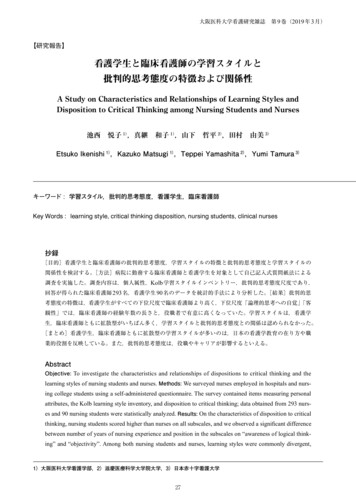
Transcription
大阪医科大学看護研究雑誌第 9 巻(2019 年 3 ��特徴および関係性A Study on Characteristics and Relationships of Learning Styles andDisposition to Critical Thinking among Nursing Students and Nurses池西悦子 1),真継和子 1),山下哲平 2),田村由美 3)Etsuko Ikenishi 1),Kazuko Matsugi 1),Teppei Yamashita 2),Yumi Tamura 3)キーワード : �学生,臨床看護師Key Words : learning style, critical thinking disposition, nursing students, clinical �性,Kolb ��思回答が得られた臨床看護師 293 名,看護学生 90 える。AbstractObjective: To investigate the characteristics and relationships of dispositions to critical thinking and thelearning styles of nursing students and nurses. Methods: We surveyed nurses employed in hospitals and nursing college students using a self-administered questionnaire. The survey contained items measuring personalattributes, the Kolb learning style inventory, and disposition to critical thinking; data obtained from 293 nurses and 90 nursing students were statistically analyzed. Results: On the characteristics of disposition to criticalthinking, nursing students scored higher than nurses on all subscales, and we observed a significant differencebetween number of years of nursing experience and position in the subscales on “awareness of logical thinking” and “objectivity”. Among both nursing students and nurses, learning styles were commonly 十字看護大学27
大阪医科大学看護研究雑誌第 9 巻(2019 年 3 月)and no relationship was observed between learning style and disposition to critical thinking. Conclusion: Thefact that diverging learning styles were common among both nursing students and nurses reflects the state ofnursing education and occupational roles in Japan. The disposition to critical thinking can also be affected byposition and ��基礎となる能力であり(Ssedlak, 面である態度や気質という 2 �る(Atkins, �てICT スタイルを Kolb ��。28
大阪医科大学看護研究雑誌第 9 巻(2019 年 3 月)で構成された 33 項目からなり,「あてはまる:5 点」Kolb は学習スタイルとして,以下の 4 �い:1 点」の 5 件法で回答する「収束型(converging �囲は 33 165 点である。なお,「発散型(diverging ��間「同化型(assimilating ら学ぶ傾向にある。2017 年 4 月 1 日 2018 年 3 月 31 ng 質問用紙,返信用封筒(封あり)を 1 トは Stat Flex ver.6,Excel 。それぞれの有意水準は 5 ��大学 1 �習スタイルは4つの学習モード(CE: ��頭で説明し,同crete experience, RO: reflective observation,意が得られた者とした。AC: abstract conceptualization, AE: �を実施した。調査内容は,個人AE-RO ��護4 ��いえることから,4 �� 9 つに分類した。尺度(Kolb, ��)批判的思考態度尺度は 4 �4 つの単語からなる 12 �」「証拠の重視」の 4 因子後の多重比較は Turkey 法にて検討した。29
大阪医科大学看護研究雑誌第 9 巻(2019 年 3 �思考態度尺度の表 2 臨床看護師の背景(n �については,Mann-Whitney test ey �員会(滋慶大学倫 第 2017-2 �看 �表1に示す。看護学生は 3・4 年に示す。生であり,3 年生 30 人(39 %),4 年生が 47(61 %)看護学生の総得点の範囲は 33 165 �が 61 人(79.2 %),大学は 114.4 13.7 点であった。4 つの下位尺度では,「論卒が 16 名(20.8 �得点の範囲は 13 65 点で,臨床看護師の背景を表 2 に示す。年齢は,30 歳以平均は 45.3 5.9 � 186 人(59 �囲は 10 50 点で,平均は 34.6 4.9 点であっ験年数は,1 31年であり,5 10年が 88人(27.9 ��得点の範囲は 7 35 点で,平均いているものが 135 人(42.9 %),スタッフが 169は 23.7 3.8 �の範囲は 3 15 点で,平均は 10.7 1.8 点であった。人(54.7 �卒臨床看護師の総得点の範囲は 33 165 点で,平均が 211 人(67 %)と最も多く,次いで大学卒 80 人は,108.9 13.6 点であった。4 つの下位尺度では,(25.4 %)であった。表 1 �の総得点の範囲は 13 65 点で,平均は 43.0 5.6 点であった。「探究心」の総得点(n 77)の範囲は 10 50 点で,平均は 33.1 4.5 �囲は 7 35 点で,平均は 22.7 3.7 �の範囲は 3 15 点で,平均は 10.0 1.8 ,30
大阪医科大学看護研究雑誌第 9 巻(2019 年 3 月)表 3 �� 4 ��差31
大阪医科大学看護研究雑誌第 9 巻(2019 年 3 月)表 5 �探求心客観性3年 (n 30)40.5 5.3841.6 6.1926.0 3.784年 (n 47)39.7 8.09高校卒 (n 61)39.9 7.05大学卒 (n 16)40.4 7.65N.S.38.5 7.10N.S.25.3 3.6339.3 7.23N.S.41.2 5.32証拠の重視P 0.0226.1 3.76N.S.23.9 2.8510.2 1.9510.2 2.02N.S.10.1 1.84N.S.10.4 2.50N.S.Mann-Whitney test表 6 �下位尺度)との関係表6年齢 *1看護師経験年数 *1職位 *2最終学歴 *2リフレクション経験の有無 � (n 149)37.5 7.3036.8 7.4324.7 3.1510.1 2.0531 40歳 (n 50)39.4 7.4238.2 6.7725.0 3.1841 50歳 (n 33)40.1 7.4051歳以上 (n 23)41.0 9.8636.3 6.2925.9 3.7310.5 2.643年未満 (n 46)36.0 6.8636.8 7.5323.8 3.369.7 1.993年以上5年未満 (n 48)35.9 7.1736.2 7.6424.4 3.139.9 1.975年以上10年未満 (n 65)39.6 7.05 P 0.0008536.9 6.9125.4 2.85 P 0.0143910.5 2.0810年以上15年未満 (n 38)39.4 7.6037.8 7.7525.2 3.2310.5 1.9015年以上 (n 58)41.0 8.3437.1 6.5725.8 3.3510.5 2.07役職者 (n 114)40.9 7.5738.0 7.0225.6 3.01スタッフ (n 135)36.5 7.13その他 (n 6)39.2 9.2833.5 8.6224.5 4.23高校卒 (n 6)36.8 8.9835.0 8.1722.7 5.13専門学校卒 (n 166)39.0 8.01短大卒 (n 17)36.7 7.73大学卒 (n 66)38.0 6.5837.6 7.3824.7 3.16ある (n 36)38.1 6.6737.1 6.8624.0 3.23ない (n 219)38.6 7.82N.S.P 0.00002いずれもN.S.N.S.36.1 7.2736.3 7.1836.8 7.1836.1 6.3636.9 7.25N.S.25.5 3.25N.S.いずれもN.S.いずれもN.S.N.S.24.4 3.2925.1 3.2525.0 2.2925.1 3.20N.S.P 0.0125910.4 2.0010.3 1.46N.S.N.S.10.5 2.1610.0 1.90いずれもN.S.10.2 1.8311.3 1.37いずれもN.S.10.2 2.0910.5 1.74いずれもN.S.10.1 1.97N.S.9.8 1.8910.3 2.04N.S.*1 One-way ANOVA *2 Tukey test *3 Mann-Whitney ��5 �が,3 年生 26.0 3.78,4年生 25.3 3.63 で,3 �較について表 6 1 人(46.1 %)であり,2 の平均が,役職者 40.9 7.57 点,スタッ17 人(19.1 %)であった。フ 36.5 7.13 点の平均が,役職者 ��スタイルの比率 3.01 点,スタッフ 24.4 3.29 ��に高かった。人(60.7 �念32
大阪医科大学看護研究雑誌第 9 巻(2019 年 3 ��一 般 大 学 生 を 対 象 と し た 調 査 結 果( 平 山 ��」が 37.1 7.9 点,「探求心」37.9 6.4 点,「客観性」23.9 4.3 点,「証拠の重視」10.3 2.3 ��」は本結果が 8.2 点高く,「探求心」は 3.3 点低かった,「客観性」は 0.2 点低く,「証拠の重視」は 0.4 �,根拠に基づいた看護図 1 の過密さがい図 2 ��型」38 人(15.6 �較において,下位尺度「客観性」で 3 ��いて,尺度の得点について Tukey test ��ため実習直後の時期にあった 3 �ではないかと考える。4 年生もすでに実習33
大阪医科大学看護研究雑誌第 9 巻(2019 年 3 的思考へPBL ��タイルである。Kolb は 3 ��階理論(Kolb, 一段階(獲得段階 acquisition)には,4 �する,人specialization)には 2 ation)には,これら 4 �用することができるバラるには,4 �論(Kolb, の学習ス外界との接触の仕方 ( ��三段象的 ) �ことにより,34
大阪医科大学看護研究雑誌第 9 巻(2019 年 3 �となる。特に,収る(Kolb, ��傾向にある(Kolb, ��合させるリフレクション教育や PBL ��ル) ��を用いるかを検討する際央型」の 4 �ングや PBL �後の 3 年生の方が 4 験と熟考的観察から学ぶ傾向にあ35
大阪医科大学看護研究雑誌第 9 巻(2019 年 3 �。tice Hall.Kolb DA, Boyatzis RE, Mainemelis C(2001):Experientiallearning theory: Previous research and new directions.Ⅷ.研究の限界In R.J. Sternberg and L-F. Zhang(eds.)Perspectives 純無作為抽出Thinking, Learning and Cognitive そのため,結果を一般化するJersey: Lawrence �利益相反は存在しない。Richard LF,Shirley AR(1997):Learning Style of Political Science Students.Political Science & 論―欧米の研Sedlak CA(1997):Critical thinking of beginning �究,2(1),197-212.reate ursing students during their first clinical couse, Jour-Atkins S, Murphy C(1993):Reflection: a review of the lit-nal of Nursing Educaion, 36, 11-18.erature. JAN .B.& 4):第 3 章 ��かすリフレクション 0000013l4m.pdf(2018- 10-31)Kolb DA(1984):Experiential Learning: Experience as theSource of Learning and Development.New Jersey,Pren-36
GU J G¶ Z v½y H 9 è 2019 å 3 D y Kolb x ¶ 6 µ » ç q o w 4 m [ oM { ) conver ging style t Å æ q ó îgT ¶ ²tK { C diver ging style é . &gq Yß oT ¶ ²tK { assimilating style Å æq Yß oT ¶ ²tK { & accommodating style é . & g q ó .